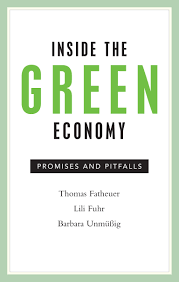Inside the Green Economy (HBS)
Thomas Fatheuer, Lili Fuhr and Barbara Unmüßig / Heinrich Boell Stiftung / 2016
 A central theme of this book is that the “concept of the Green Economy offers a new model, based primarily on large-scale technological solutions. But the Green Economy cares little about politics, barely registers human rights, does not recognize social actors and suggests the possibility of reform without conflict. It suggests that the world as we know it can continue with green growth.”
A central theme of this book is that the “concept of the Green Economy offers a new model, based primarily on large-scale technological solutions. But the Green Economy cares little about politics, barely registers human rights, does not recognize social actors and suggests the possibility of reform without conflict. It suggests that the world as we know it can continue with green growth.” —————
The introduction notes that: “Green Economy is a source of both hope and controversy. For some, it points the way out of permanent environmental and economic crises and promises to reconcile – a long cherished Utopia – ecology and economics. It fosters the hope that we can hang on to our current high standard of material prosperity.”
—————
It goes on to state that: “for the many who have so far been excluded from prosperity, inclusion is supposed to become possible thanks to the Green Economy paradigm. And both goals are to be accomplished while keeping within the biophysical boundaries of our planet. For others, Green Economy is “business as usual” dressed up in green, or merely a greenwashing manoeuvre which does not stop the overexploitation of the planet and even exacerbates social disparities.”
—————–
Ever since it was put forward as a central theme of the Rio+20 conference in 2012 the green economy concept has been heavily contested because “it is about much more than environmental conservation”. It is about fundamental questions such as “how do we want to live in future? How do we want to share our planet’s limited resources with each other? What is the “good life”?”.
—————–
The introduction goes onto explain how we have taken many wrong turns e.g.
- that a tonne of CO2 equals a tonne of CO2 no matter where it was emitted
- that other greenhouse gases can be counted in CO2 equivalents
- “net zero emissions” which implies “that the world can continue to produce emissions so long as new technologies are invented to suck carbon out of the atmosphere at a later stage – instead of embarking on a radical trajectory that leaves fossil fuels in the ground, changes our agricultural systems and restores our natural ecosystems.”
This “obsession with carbon metrics helps to promote nuclear energy, natural gas extraction (including fracking), biofuels and other risky and harmful technologies, so long as they can claim to emit less carbon than was expected to be emitted without them.”
There is much talk of the Green Economy as an exit from “business as usual” capitalist model but is this really true and is there “really political and social consensus about what that means?” The authors state that “the permanent social, economic and environmental crises are closely interlinked” and observe that “Many Green Economy advocates also see how great the challenges are. But when it comes to solutions, all too often, they confine themselves to technological innovations and new markets”.
—————–
The chapter ends with “This book is an invitation to join the debate. We are neither the arbiters of truth, nor do we claim to have perfect insight into the crises and solutions with all their diversity, complexity and interdependency. Indeed, it is doubtful that any individual alive can make such a claim. But for that very reason, our concern is to put forward a fundamental and maximally comprehensive critique of Green Economy conceptions”.
Inside the Green Economy webpage
Sample chapters include:
————————————
This summary was prepared by Why Green Economy?. The views expressed have been paraphrased. See the original source for more information.

Leave a Reply